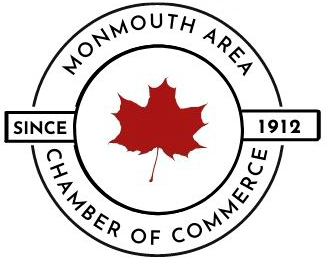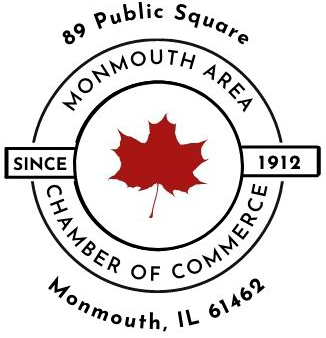Woodbine is a fragrant climbing plant with purple-tinged yellow flowers, more commonly known as European honeysuckle. It’s not surprising that two Victorian-era sisters named Woods appropriated the name to christen their “cottage” — a fanciful towered Queen Anne mansion that stood directly opposite the Monmouth College campus.
When erected by their father as a retirement home in 1893, Alice and Omah Woods’ mansion (two lots, house and barn) cost $12,500, which in today’s dollars would equate to $360,000. After the deaths of their mother and father, the sisters eventually decided to join a movement by Monmouth’s upper class and relocate to Los Angeles. That would be beneficial to Monmouth College, which acquired the gracious residence, using it first as a women’s dormitory, then a president’s mansion, an academic building, an office building and finally a fraternity house.
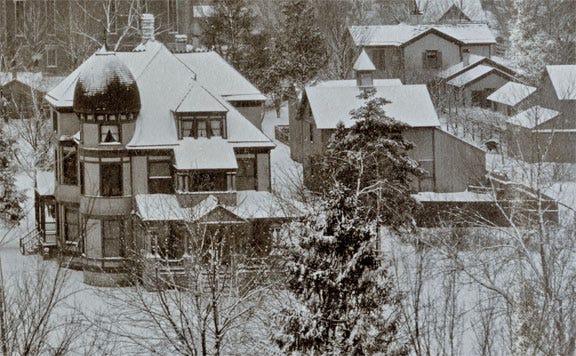
The house’s builder, James H. Woods, was a wealthy Henderson County farmer from the Reed neighborhood, nine miles west of Monmouth. Born in Princeton, Indiana, in 1827, he was 12 years old when his parents moved to Illinois and settled a farm in Rozetta Township. He spent most of his life on that farm, marrying Kentucky native Elizabeth Reed in 1849 and raising 10 children — six girls and four boys.
The Woods were devout Presbyterians and attended the nearby Smith Church. Three of the daughters — Alice, Ida and Eva — attended Monmouth College. Most of their children married and moved away, but Alice (born in 1853) and Omah (born in 1861) remained single and lived with their parents.
Their mother, Elizabeth, died at age 72 in 1898 — less than five years after moving to Monmouth with her husband and daughters. She and James were active in the Second Presbyterian Church, just a block south of their home. They were also supportive of Monmouth’s Presbyterian mission church, Ninth Avenue. Upon his death, James would leave $3,100 to its congregation for the erection of a parsonage and for current expenses.
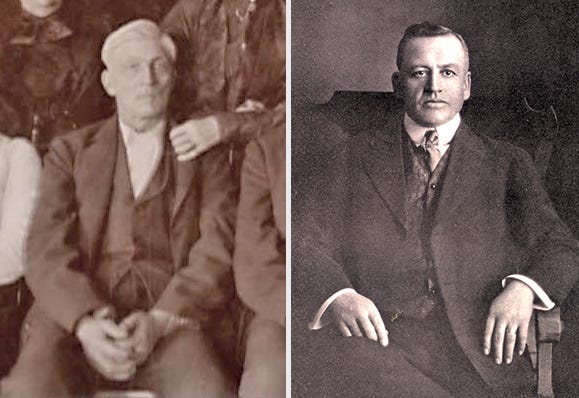
The Woods residence would become an important Monmouth College property after James’s death, but while he was still living, he sold another property that would become essential to the college of today. Woods owned a large pasture just north of the early college campus. In 1904 he sold it to his son, William H. Woods, and a partner, F. M. Hallam, who had established the prominent Monmouth real estate firm Woods & Hallam. The new owners divided it into building lots, which would eventually be purchased by the college for construction of Winbigler, Cleland and Liedman Halls, as well as a fraternity complex, library, science building and football stadium.
James Woods died in July 1911 at the age of 84. He had spent the previous winter in Florida for his health, and three weeks before his death he had visited his old Henderson County homestead in an automobile owned by F. M. Hallam. The purpose of the visit was to see a remarkable pear tree that he had planted 68 years earlier, which had borne extensive fruit nearly every year since. He had planned to attend a niece’s wedding in Tarkio, Missouri, the following week, but became suddenly ill and never recovered.
Woods left his home to Alice and Omah, and most of his farm to Alice, his eldest child. By 1916, the Woods sisters, who were 63 and 55 respectively, decided to retire to California and approached Monmouth College president Thomas McMichael to see if he was interested in the family home. The college had recently opened its first residence hall, McMichael Home for women, but there was still not sufficient lodging available for women students, so McMichael embraced the idea.
The college Senate voted to pay the sisters $5,000 cash and established a $2,000 annuity bond to compensate them during the remainder of their lives. It also established a $3,000 scholarship in their name. Alice would make news in 1950 at age 94, when she was recognized in Newsweek magazine for being tied for the second-oldest living woman college graduate in the nation.
Woodbine Cottage opened to Monmouth College women in the fall of 1916. It was not long, however, before the Student Army Training Corps was established on campus to train male students for entry into World War I. The house and barn in back became the men’s barracks, housing 80 cadets. When the Spanish Influenza struck in 1918, the cadets were issued gauze masks and the ones who became ill were moved into quarantine.
Following the war, the name “Woodbine” was resurrected, and President McMichael moved his family into the elegant home, which would become the presidential residence for next 30 years. In 1949, the college purchased the Pattee home, two blocks west, for a new president’s home. Woodbine reverted briefly to a dormitory before being turned into offices for public relations and alumni records, and renamed Alumni Hall. In 1957, the building was taken over by the business administration and economics departments, and also served for a time as home to the art department.
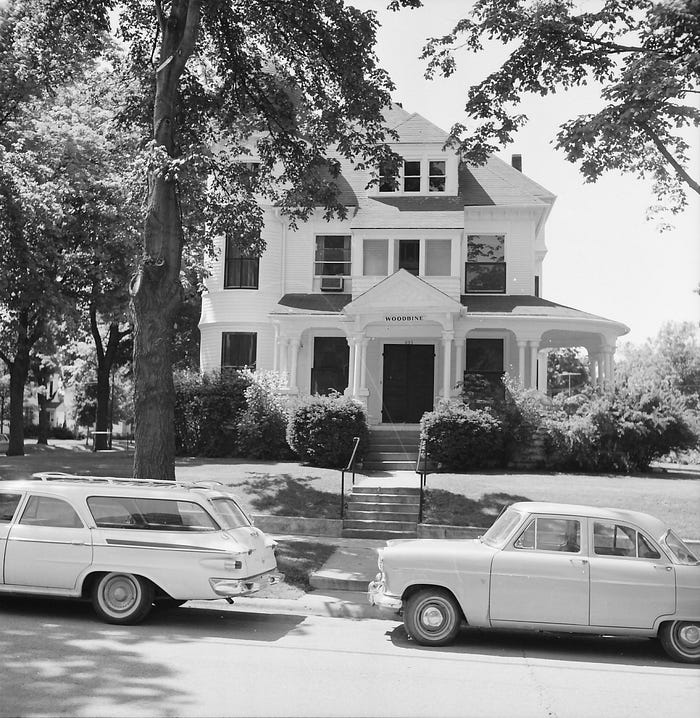
After business and economics moved out in 1974, Woodbine stood vacant for a year. Then the newly chartered Zeta Beta Tau chapter took possession and lovingly restored it for their new fraternity house. In 1984, the ZBTs vacated Woodbine, moving into the former Sigma Alpha Epsilon house. Several months later, the empty home was razed by the college.
In 2010, ground was broken for a new “Woodbine” — a $2 million 6,000-square-foot Queen Anne-style residence that today houses the Alpha Xi Delta women’s fraternity.
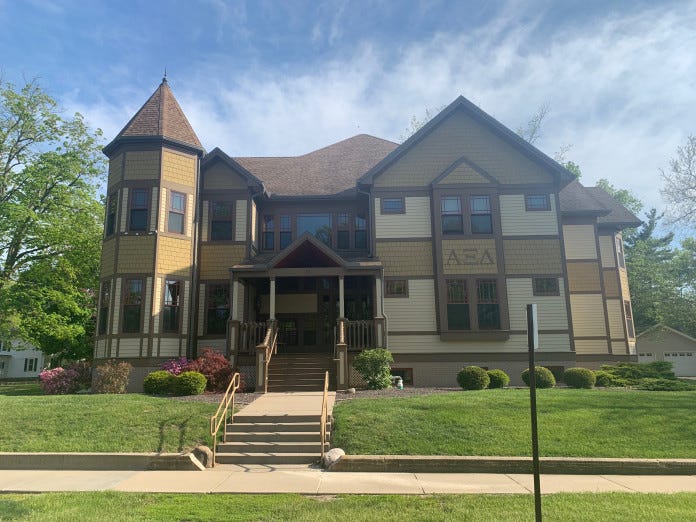
Although Alice and Omah Woods left town in 1916, the Woods legacy would live on in Monmouth for decades. Their brother William, who had attended Quincy Business College, began working for the Monmouth National Bank as a bookkeeper in 1890 and helped organize the Trust and Savings Bank in 1903, serving as its first cashier. In 1905, he was elected president of the rapidly growing Illinois Bankers Life Assurance Co., which would one day become Monmouth’s largest business.
In 1911, along with his real estate business partner, F. M. Hallam, Woods constructed the sprawling Woods & Hallam building on West First Avenue. Its principal occupant would be Illinois Bankers Life. Woods, whose wife died in 1918, leaving two daughters, married Stella Rowley in 1920. They built a modern brick home at 403 East Broadway, where they raised their sons — James, born in 1921, and William, born in 1927.
William died in 1942 but Stella lived until 1981. Her son, James, attended Monmouth College, where he met his future wife, Gayle Nelson. After the couple married in 1942, he entered the Army Air Corps where he was a flight officer, flying supplies over the “hump” in the India-China theater during World War II. He later became a pilot for Pan American Airlines. After the death of his mother, James and Gayle retired to the family home on Broadway. James died in 1996 and Gayle died in 2002.

by Jeff Rankin
Editor and historian for Monmouth College. Avid researcher of western Illinois history for 40 years. FB and Twitter. jrankin@monmouthcollege.edu
